CHARLOTTENBURG AND SPANDAU
The sophisticated haute bourgeoisie enclave of Charlottenburg was the only Berlin district that did not touch the Wall. The historical streets off Ku’damm feature galleries, boutiques, cafés and restaurants set in stout early 20th-century residential houses. These streets and the proud town hall remind us that this was once Prussia’s richest town, which was only incorporated into the city of Berlin in 1920. Spandau, on the other side of the Spree and Havel, is almost rural in comparison, with a Late Medieval core and citadel that make it seem like a small independent town.
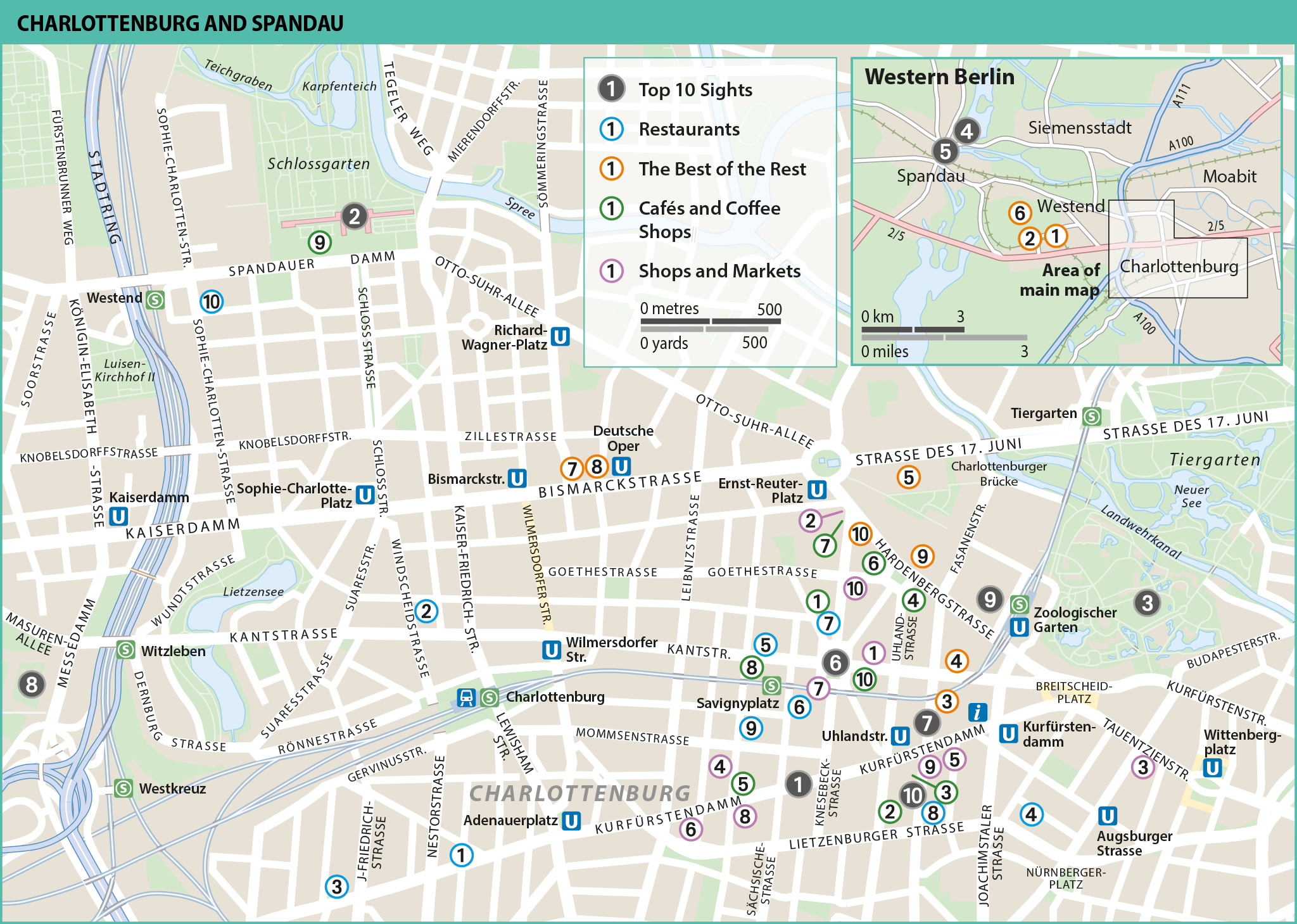
1. Kurfürstendamm
This famous Berlin boulevard (see Kurfürstendamm) was frequented by writers, directors and painters in the interwar years. Today it is a lively avenue lined with designer stores and elegant cafés.
2. Schloss Charlottenburg
The Baroque and English-style gardens of this Hohenzollern summer residence (see Schloss Charlottenburg) are ideal for a stroll. The palace's restored interiors are stunning.

Palace detail, Charlottenburg
3. Zoologischer Garten
Founded in 1844, this is the country’s oldest and most prominent zoological garden, combined with an aquarium.
4. Zitadelle Spandau
![]() Am Juliusturm • Open 10am–5pm daily • (030) 354 94 40 • Adm • www.zitadelle-berlin.de
Am Juliusturm • Open 10am–5pm daily • (030) 354 94 40 • Adm • www.zitadelle-berlin.de
Berlin’s only surviving fortress, this citadel is sited at the strategic confluence of the Havel and Spree. The structure, built in 1560 by Francesco Chiaramella da Gandino, was based on Italian forts. The Juliusturm, a remnant of a fortress that stood here as early as the 12th century, was used as a prison in the 19th century. At the time, Berliners used to say “off to the Julio” when they sent criminals to prison. Later, the reparations paid by France after its defeat in the Franco-Prussian War of 1870–71 were kept here. The City History Museum of Spandau is located in the former arsenal of the citadel.

The imposing Zitadelle Spandau
5. Spandau Old Town
![]() Breite Str., Spandau
Breite Str., Spandau
When walking around Spandau’s pedestrianized Old Town (Altstadt), it is easy to forget that you are still in Berlin. The narrow alleyways and nooks and crannies around the 13th-century Nikolaikirche are lined by Late Medieval houses, a reminder that Spandau was founded in 1197 and is older than Berlin itself. The Gotisches Haus – the oldest house in Berlin, dating back to the late 15th century – stands at Breite Straße 32. It was built of stone at a time when most houses were made of wood. It is now the Visitor Information Centre, and some of its rooms are used to showcase finds from the house and other artifacts of the period.
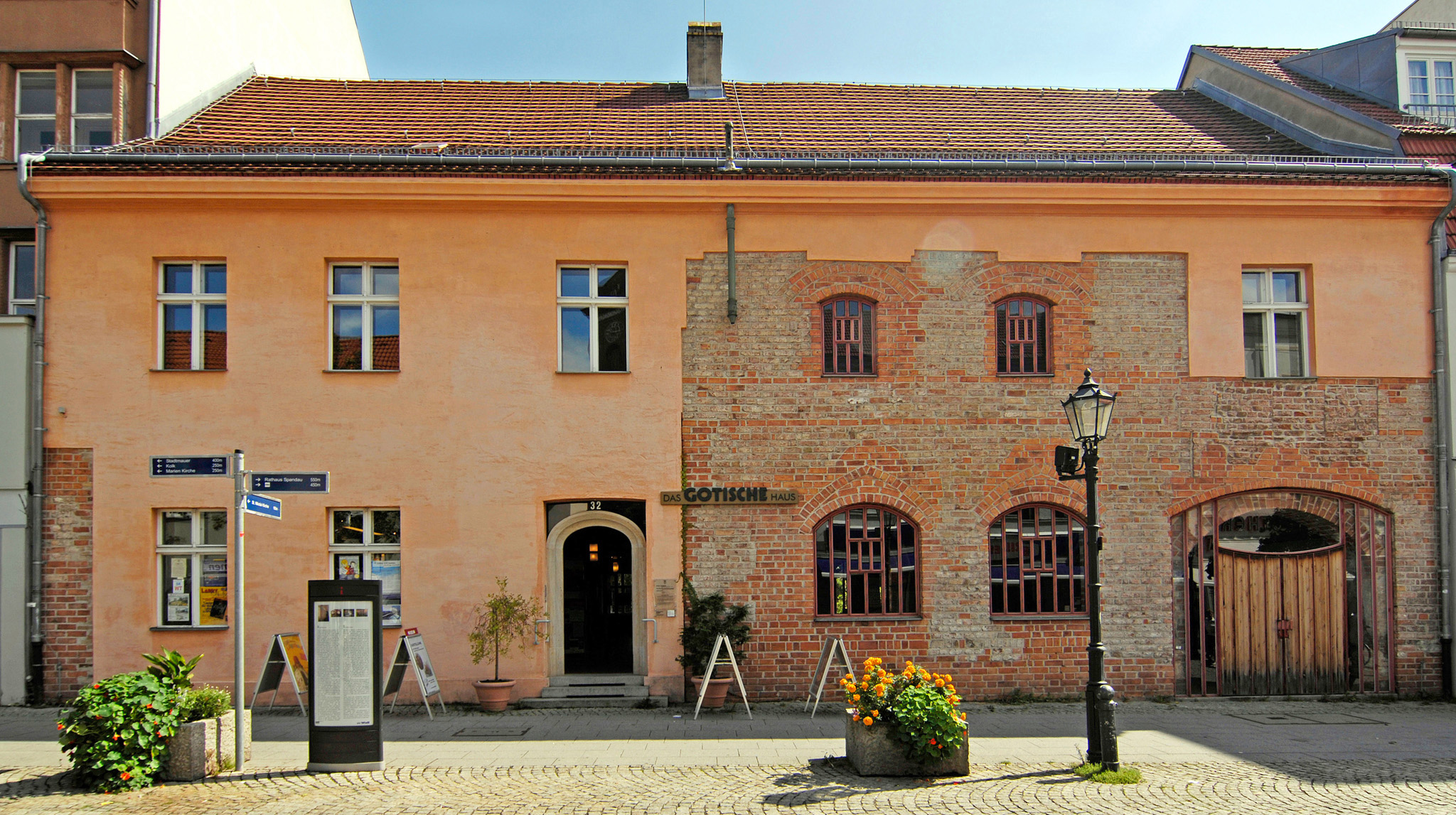
Exterior of the 15th-century Gotisches Haus in Spandau’s Altstadt
6. Savignyplatz
![]() An der Kantstr.
An der Kantstr.
One of Berlin’s stunning squares is right in the heart of Charlottenburg. Savignyplatz, named after a 19th-century German legal scholar, is known as a district for artists and intellectuals as well as for dining out and entertainment. The square has two green spaces, either side of Kantstraße. It was built in the 1920s as part of an effort to create parks in the centre of town. Small paths, benches and pergolas make it a pleasant place for a rest. Dotted all around Savignyplatz are street cafés, restaurants and shops, especially in Grolman-, Knesebeck-, and Carmerstraße, all three of which cross the square. Many have lost their way here after a night out celebrating, which is why the area is jokingly known as the “Savignydreieck” (the Savigny Triangle). In the north, you can explore some of the most attractive streets in Charlottenburg, including Knesebeck-, Schlüter- and Goethestraße. This is still a thriving Charlottenburg community; the shops, bookshops, and cafés are always busy, especially on Saturdays. South of the square, the red-tiled S-Bahn arches lure visitors with their shops, cafés and bars, particularly the Savignypassage near Bleibtreustraße and the small passageway between Grolman- and Uhlandstraße on the opposite side of the square.
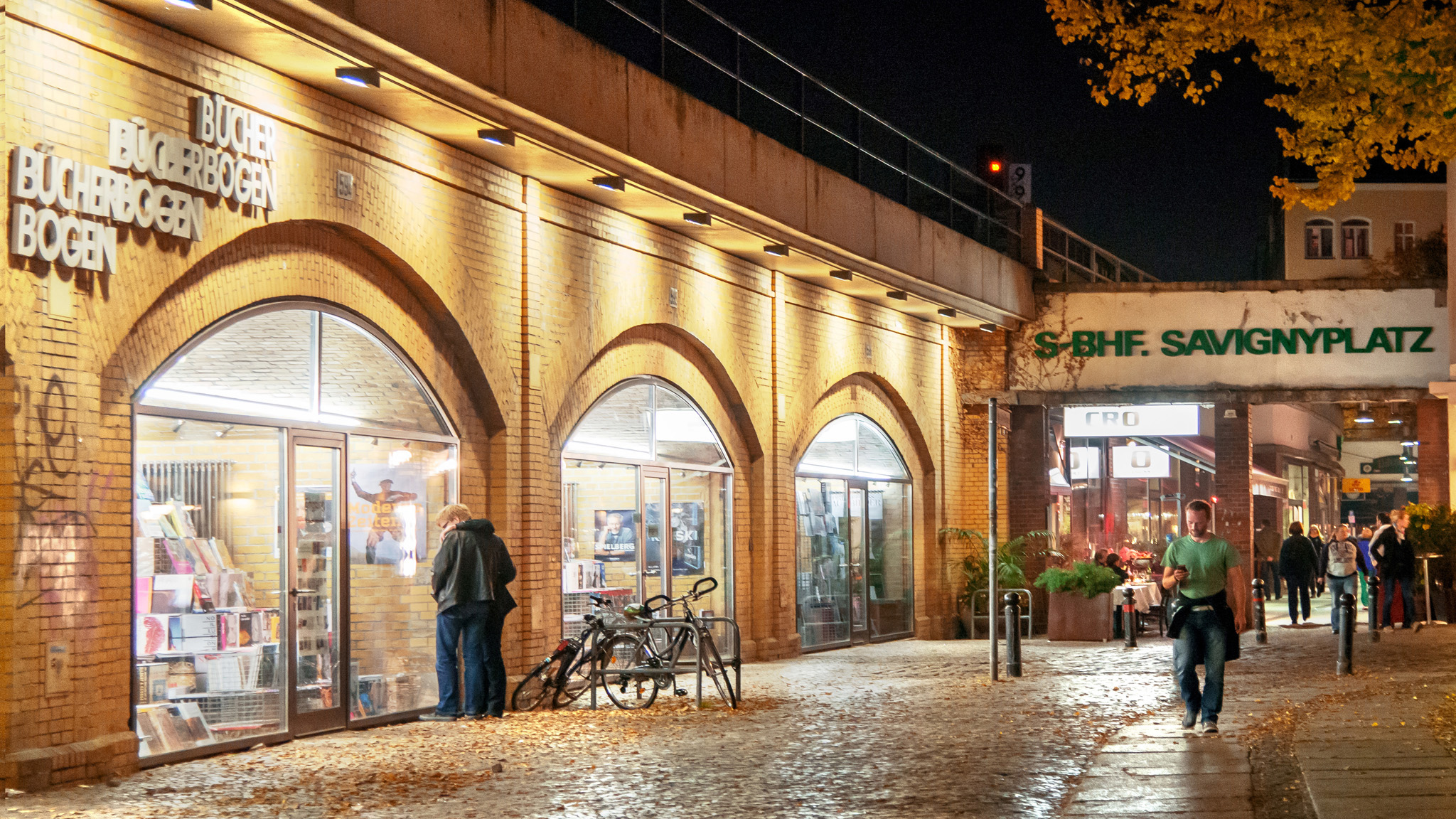
Savignyplatz at night
7. Fasanenstraße
![]() Charlottenburg
Charlottenburg
This elegant street is the most attractive and trendiest street off Kurfürstendamm. Designer shops, galleries and restaurants are tucked away in Fasanenstraße along with a retail strip catering to the masses. The junction of Fasanenstraße and Ku’damm is one of the liveliest spots in Berlin. One of the best known places is the Kempinski Hotel Bristol Berlin at the northern end of Fasanenstraße. The former bank opposite cleverly combines a historic building with a modern structure. Next to it is the Jüdisches Gemeindehaus, the Jewish community house and a little farther along, at the junction with Kantstraße, is the Kant-Dreieck. The Berliner Börse (the stock exchange), based in the ultra-modern Ludwig-Erhard-Haus, is just above, at the corner of Hardenbergstraße. The southern end of the street is dominated by residential villas, some of which may seem a little pompous, as well as the Literaturhaus, Villa Grisebach, one of the oldest art auction houses in Berlin, and the Käthe-Kollwitz-Museum, which holds about 200 of the Berlin artist’s works, including several self-portraits. There are also some very expensive fashion stores here, as well as a few cosy restaurants. At its southern end, the street leads to picturesque Fasanenplatz, where many artists lived before 1933.

Antiques store on Fasanenstraße
8. Funkturm and Messegelände
![]() Messedamm 22 • (030) 303 80 • Open 10am–8pm Mon, 10am– 11pm Tue–Sun (tower) • Adm • www.messe-berlin.de/en/
Messedamm 22 • (030) 303 80 • Open 10am–8pm Mon, 10am– 11pm Tue–Sun (tower) • Adm • www.messe-berlin.de/en/
The 150-m (492-ft) high Funkturm (TV tower), reminiscent of the Eiffel Tower in Paris, is one of the landmarks of Berlin that can be seen from afar. Built in 1924 to plans by Heinrich Straumer, it served as an aerial and as an air-traffic control tower. The viewing platform at 125 m (410 ft) provides magnificent views, while the restaurant, situated at 55 m (180 ft), overlooks the oldest part of the complex, the exhibition centre and the surrounding pavillions. The giant building in the east is the Hall of Honour built to designs by Richard Ermisch in 1936, in the colossal Fascist architectural style. On the opposite side rises the shiny silver ICC, the International Congress Centrum, built in 1975–9 by Ralf Schüler and Ursulina Schüler-Witte. Once considered one of the world’s most advanced conference centres, it has fallen into a state of disrepair and may be demolished. Nearby is the two-tier CityCube, Berlin’s new trade fair and conference facility. The expansive ExpoCenter grounds (160,000 sq m/40 acres) around it host Grüne Woche (Green Week, an agricultural fair), Internationale Tourismus Börse (ITB, a tourism fair) and Internationale Funkausstellung (IFA, the consumer electronics fair).
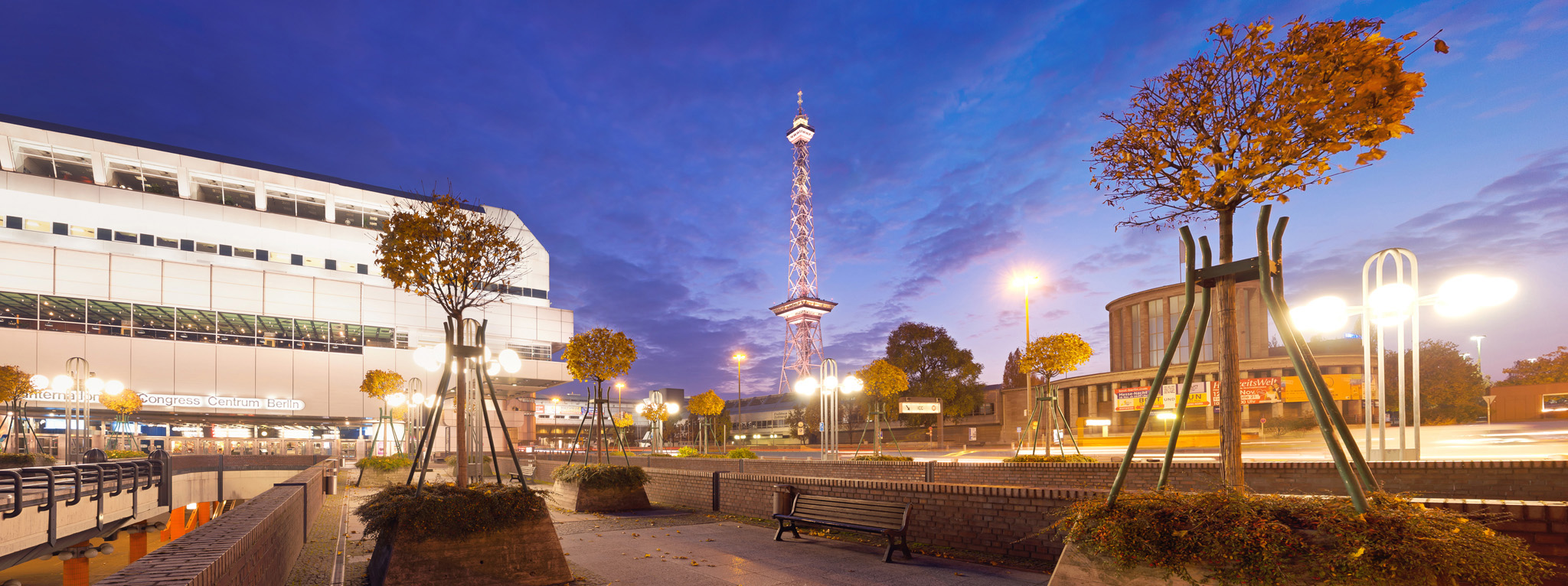
The Funkturm rising above the old ICC building at the Messegelände
9. Museum für Fotografie
![]() Jebensstr. 2 • Open 10am– 6pm Tue–Sun (to 8pm Thu) • Adm • www.smb.museum
Jebensstr. 2 • Open 10am– 6pm Tue–Sun (to 8pm Thu) • Adm • www.smb.museum
Helmut Newton (1931–2004), the world-famous photographer, has finally returned to his home city. This museum presents changing exhibitions of his early fashion and nude photography, as well as his photos of the famous, rich and beautiful, artfully captured since 1947.
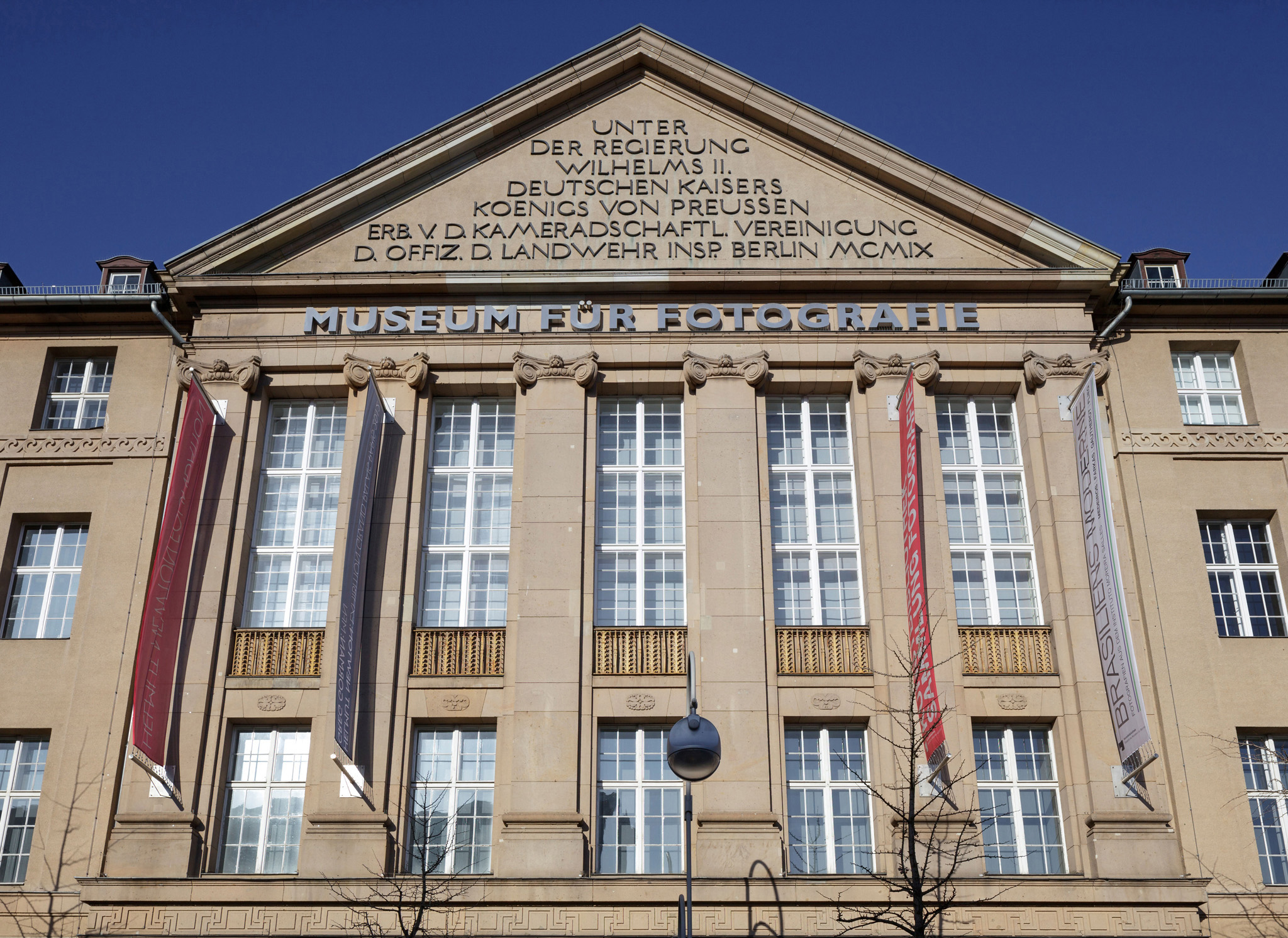
Façade of the Museum für Fotografie
10. Käthe-Kollwitz-Museum
![]() Spandauer Damm 19 • (030) 882 52 10 • Open 11am–6pm daily • Adm • www.kaethe-kollwitz.de
Spandauer Damm 19 • (030) 882 52 10 • Open 11am–6pm daily • Adm • www.kaethe-kollwitz.de
The museum is dedicated to Berlin artist Käthe Kollwitz (1867–1945), who recorded 1920s workers’ lives in prints, graphics and sketches (see Käthe Kollwitz). After losing a son and a grandson in World War I, she concentrated on the themes of war and motherhood.
SPANDAU AND BERLIN
Berliners consider the Spandauers to be rather different sorts of people, provincial and rough, and not “real” Berliners at all. But the Spandauers can reassure themselves that Spandau is 60 years older than Berlin, and proudly point to their independent history. The mutual mistrust is not just a result of Spandau’s geographical location, isolated from the remainder of the city by the Havel and Spree Rivers. It is also due to the fact that Spandau was only incorporated into Berlin in 1920. Spandauers today still say they are going “to Berlin”, even though the city centre is only a few U-bahn stops away.
A DAY IN CHARLOTTENBURG
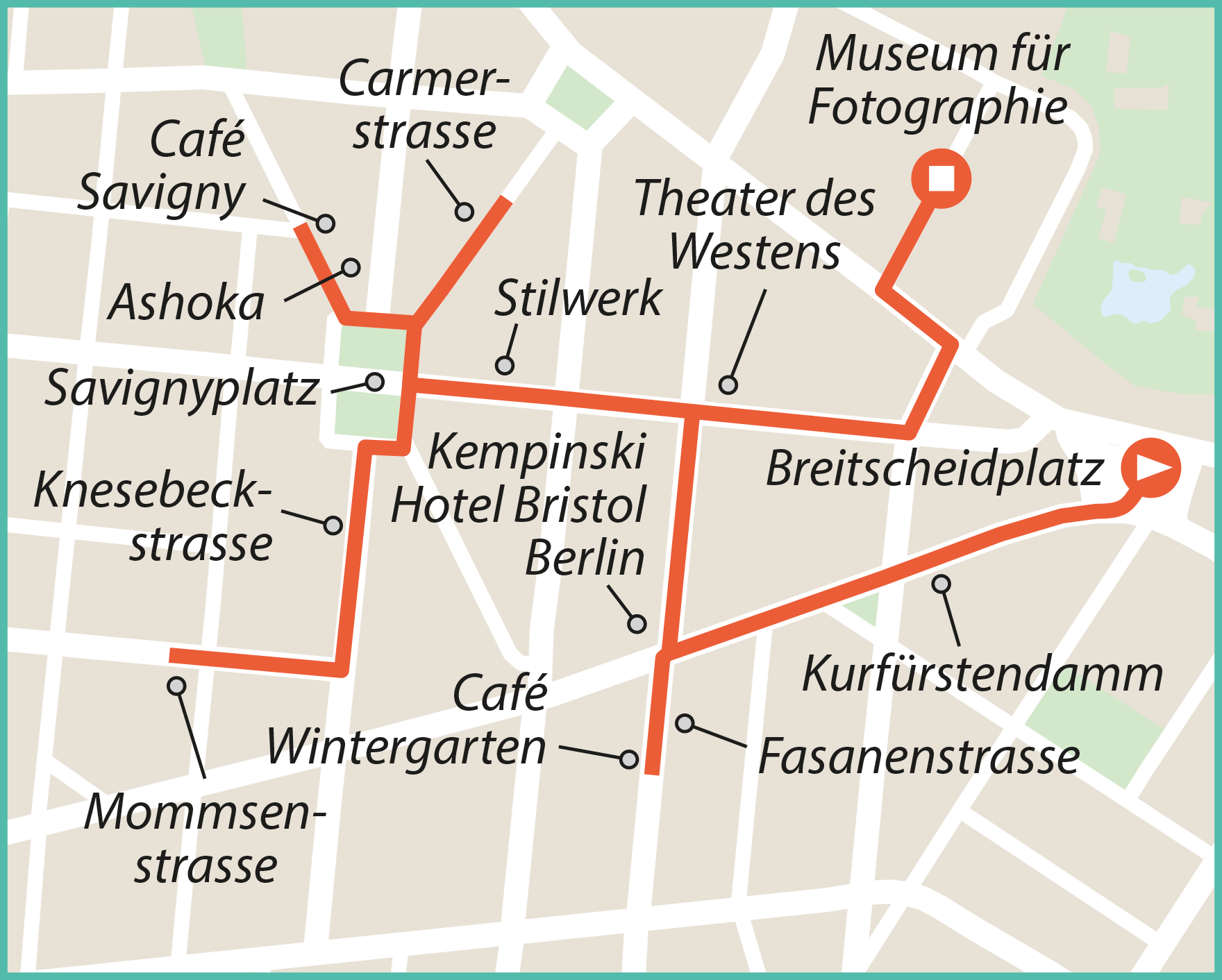
MORNING
Begin your tour of Charlottenburg at Breitscheidplatz and head west along Kurfürstendamm. At Fasanenstraße turn left to visit the Literaturhaus. You could stop for a mid-morning breakfast at the lovely Café Wintergarten in the Literaturhaus, before going back up Fasanenstraße in a northerly direction. You will pass the Kempinski Hotel Bristol Berlin on the left, and on the right you can see the Jüdisches Gemeindehaus and the Ludwig-Erhard-Haus. Diagonally opposite across Kantstraße stands the Theater des Westens. Turn left and head west along Kantstraße until you reach the shopping centre Stilwerk, a place no one has ever been known to leave without buying something.
AFTERNOON
Carry on west along Kantstraße to Savignyplatz. Northwest of the square is the tiny Indian eatery Ashoka (Grolmanstraße 51), which is a great place for lunch. Explore the small streets around the square, such as Knesebeck-, Carmer- and Mommsenstraße. Browse the small retailers for unique gifts, and visit Café Savigny for coffee and a fruit flan with whipped cream. Head back up Kantstraße and Jebensstraße to end your tour with a visit to the Museum für Fotographie where you can marvel at Helmut Newton’s iconic Big Nudes.
THE HISTORY OF CHARLOTTENBURG
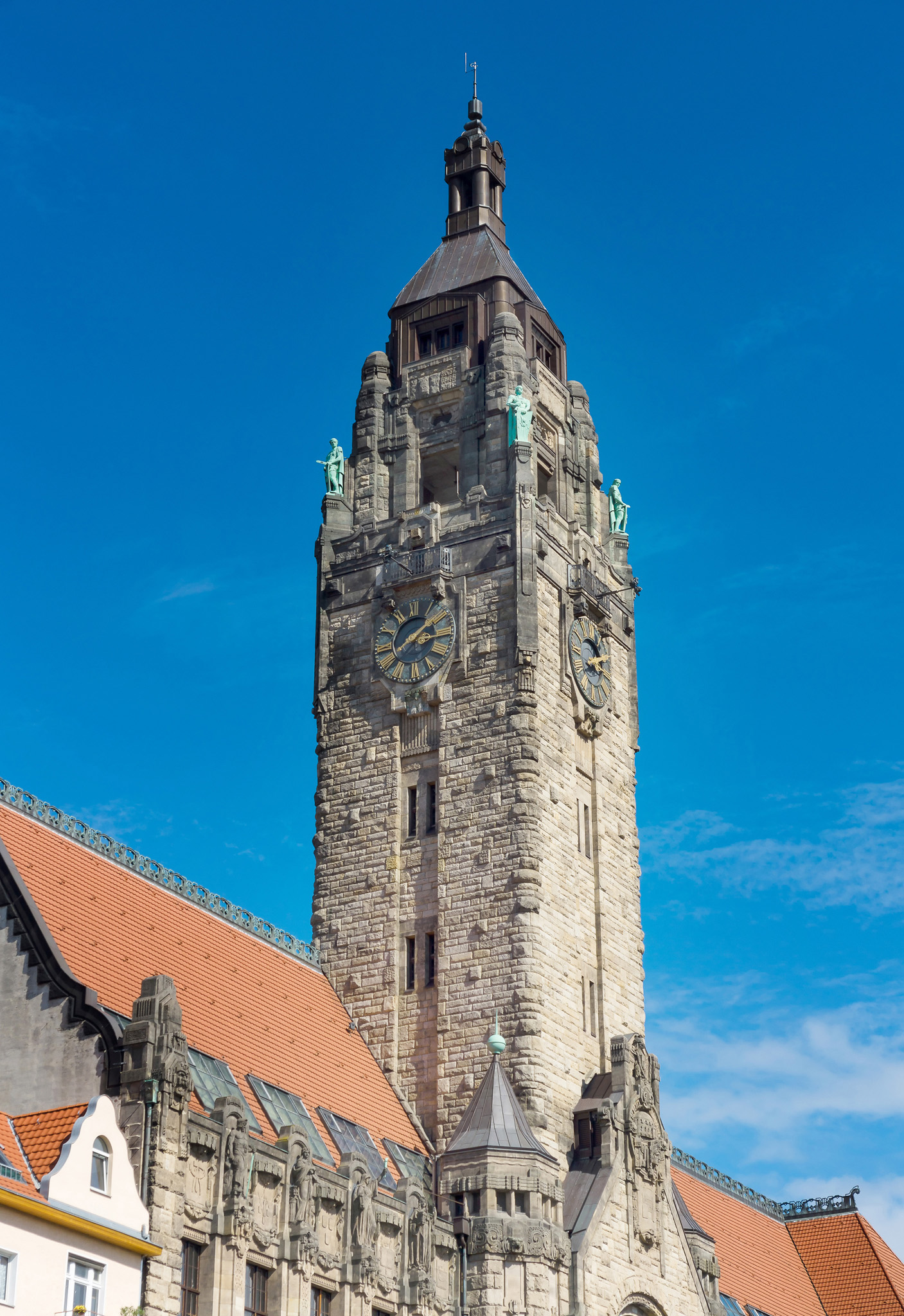
The magnificent Charlottenburger Rathaus or town hall on Otto-Suhr-Allee is a reminder of the time when this district of 200,000 people was an independent town. The town, named after the eponymous palace, arose in 1705 from the medieval settlement of Lietzow. Towards the end of the 19th century, Charlottenburg – then the wealthiest town in Prussia – enjoyed a meteoric rise following the construction of the Westend colony of villas and of Kurfürstendamm. Thanks to its numerous theatres, the opera and the Technical University, the district developed into Berlin’s west end during the 1920s.
A SPANDAU AND WESTEND WALK

MORNING
Start with a journey on the U-Bahn. From the centre of town, take a U2 train in the direction of Ruhleben, and at Bismarckstraße station change to the U7 train in the direction of Rathaus Spandau. Ten minutes later you will have reached the centre of Spandau Old Town, where you can visit Breite Straße and Nikolaikirche. Before returning to Charlottenburg, visit the Zitadelle Spandau. There, in the Zitadellenschänke, you can also enjoy a late breakfast. Return by U-Bahn, getting off at the Wilmersdorfer Straße station, one of the few pedestrianized areas in Berlin. This is a particularly good area for shopaholics and bargain hunters.
AFTERNOON
From Wilmersdorfer Straße a 30-minute walk west along Kantstraße and Neue Kantstraße will take you to the Funkturm and Messegelände with the “Ehrenhalle”. Have lunch at the Funkturm-Restaurant and enjoy the magnificent views. The Haus des Rundfunks (broadcasting house) nearby and the Georg-Kolbe-Museum, a 25-minute walk (or brief S-Bahn ride) away, are worth visiting. Then, if you still have time and energy, take the S-Bahn to the Olympiastadion. In the evening, return to Savignyplatz by S75 from S-Olympiastadion. End your day by enjoying inventive, hearty Franconian cooking at the famed Florian.
The Best of the Rest
1. Georg-Kolbe-Museum
![]() Sensburger Allee 25 • (030) 304 21 44 • Open 10am–6pm Tue–Sun • Adm • www.georg-kolbe-museum.de
Sensburger Allee 25 • (030) 304 21 44 • Open 10am–6pm Tue–Sun • Adm • www.georg-kolbe-museum.de
Sculptures by Kolbe (1877–1947) are exhibited in his home and workshop.
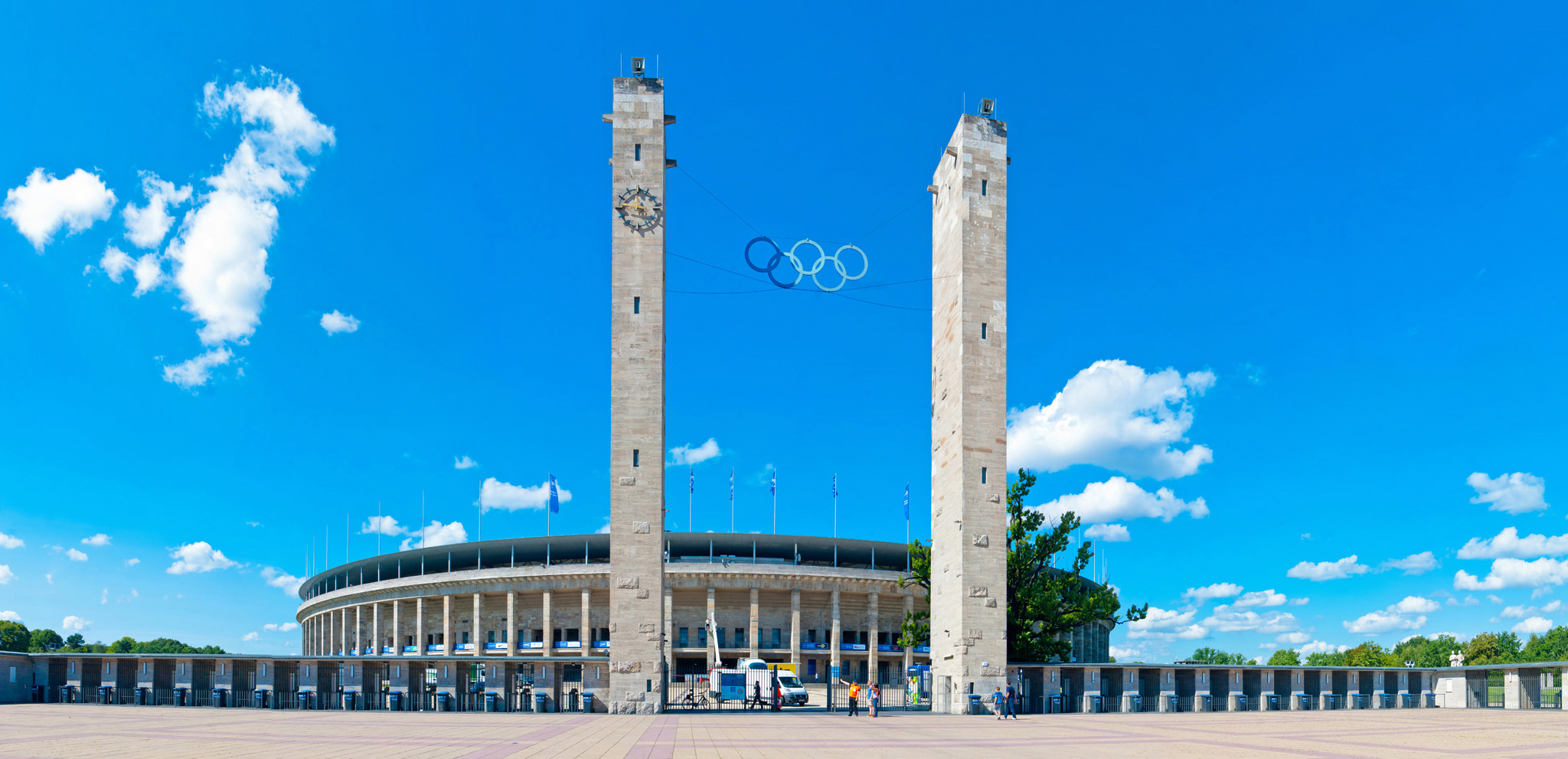
The Fascist-style architecture of the Olympiastadion
2. Le-Corbusier-Haus
![]() Flatowallee 16
Flatowallee 16
This innovative block was built for the 1957 Interbau trade fair. French architect Le Corbusier lived here.
3. Jüdisches Gemeindehaus
![]() Fasanenstr. 79–80 • (030) 88 02 82 06
Fasanenstr. 79–80 • (030) 88 02 82 06
The Jewish community house stands on the site of the Charlottenburg synagogue. It was damaged during Reichskristallnacht on 9 November 1938 and mostly destroyed during World War II. Only the portal remains.
4. Theater des Westens
![]() Kantstr. 12 • (0180) 544 44 • Ticket Office: 8am–9pm daily
Kantstr. 12 • (0180) 544 44 • Ticket Office: 8am–9pm daily
Located in a building from 1895–6, this theatre (see Theater des Westens) is regarded as one of Germany’s best musical theatres.
5. Technische Universität
![]() Str. des 17. Juni • (030) 31 40 • Open 8am–8pm Mon–Fri
Str. des 17. Juni • (030) 31 40 • Open 8am–8pm Mon–Fri
Berlin’s Technical University was founded in 1879.
6. Olympiastadion
![]() Olympischer Platz • (030) 25 00 23 22 • Open mid-Mar–Oct: 9am–7pm daily (until 8pm Aug); Nov–mid-Mar: 10am–4pm daily)
Olympischer Platz • (030) 25 00 23 22 • Open mid-Mar–Oct: 9am–7pm daily (until 8pm Aug); Nov–mid-Mar: 10am–4pm daily)
Built for the 1936 Olympic Games, the stadium is an example of Fascist architecture favoured by the Nazis.
7. Deutsche Oper
![]() Bismarckstr. 34–37 • (030) 34 38 43 43 • Adm • www.deutscheoperberlin.de
Bismarckstr. 34–37 • (030) 34 38 43 43 • Adm • www.deutscheoperberlin.de
This opera (see Deutsche Oper) specializes in Italian and German classics.
8. Denkmal Benno Ohnesorg
![]() Bismarckstr.
Bismarckstr.
Alfred Hrdlicka’s 1971 sculpture honours student Benno Ohnesorg, who was shot dead here in April 1967.
9. Universität der Künste
![]() Hardenbergstr. 32–33 • (030) 318 50 • Open 8am–6pm Mon–Fri
Hardenbergstr. 32–33 • (030) 318 50 • Open 8am–6pm Mon–Fri
The School of Art is one of the best German universities for the fine arts, architecture and design.
10. Renaissance Theater
![]() Knesebeckstr. 100 • (030) 315 97 30 • Tickets: (030) 312 42 02
Knesebeckstr. 100 • (030) 315 97 30 • Tickets: (030) 312 42 02
A gem of Art Deco architecture, this little venue has been run as an actors’ theatre since the 1920s.
Shops and Markets
1. Stilwerk
![]() Kantstr. 17 • (030) 31 51 50 • Open 10am–8pm Mon–Fri, 10am–6pm Sat
Kantstr. 17 • (030) 31 51 50 • Open 10am–8pm Mon–Fri, 10am–6pm Sat
A shopping centre (see Stilwerk) with a focus on designer home furnishings.

Stilwerk in Charlottenburg
2. Manufactum Store
![]() Hardenbergstr. 4-5, • (030) 24 03 38 44• Open 10am–8pm Mon–Sat
Hardenbergstr. 4-5, • (030) 24 03 38 44• Open 10am–8pm Mon–Sat
A unique store with a lovely selection of classic and sustainable textiles, retro design furniture, garden tools, lamps and office supplies.
3. Peek & Cloppenburg
![]() Tauentzienstr. 19 • (0800) 555 90 50 • Open 10am–8pm Mon–Sat
Tauentzienstr. 19 • (0800) 555 90 50 • Open 10am–8pm Mon–Sat
Offering five floors of men’s, women’s and children’s clothing, this is one of Berlin’s most popular stores.
4. Amorph Black
![]() Schlüterstrasse 37 • (030) 88 72 09 24 • Open 11am–7pm Mon–Sat
Schlüterstrasse 37 • (030) 88 72 09 24 • Open 11am–7pm Mon–Sat
This trendy concept store offers a great choice of top brands and has a good inhouse collection.
5. TITUS Berlin Zoopreme
![]() Meinekestr. 2 • (030) 32 59 32 39 • Open 10am–8pm Mon–Sat
Meinekestr. 2 • (030) 32 59 32 39 • Open 10am–8pm Mon–Sat
The latest must-have labels are stocked at this streetwear store.
6. Jil Sander
![]() Kurfürstendamm 185 • (030) 886 70 20
Kurfürstendamm 185 • (030) 886 70 20
Simple, elegant designer fashions for men and women are for sale at this cool boutique.
7. Bücherbogen
![]() Stadtbahnbogen 593 (Savignyplatz) • (030) 31 86 95 11
Stadtbahnbogen 593 (Savignyplatz) • (030) 31 86 95 11
Berlin’s leading arts and photography bookseller is tucked away within three arches under the S-Bahn viaduct.
8. Patrick Hellman
![]() Schlüterstr. 45 • (030) 88 48 77 16/19 • Open 10am–7pm Mon–Fri, 10am–6pm Sat
Schlüterstr. 45 • (030) 88 48 77 16/19 • Open 10am–7pm Mon–Fri, 10am–6pm Sat
Gentlemen’s fashions made from the best materials, including Hellmann’s own collection and clothes from well-known designers can be found here.
9. Tee Gschwendner
![]() Kurfürstendamm 217 • (030) 881 91 81 • Open 10am–7pm Mon–Fri, 10am–4pm Sat
Kurfürstendamm 217 • (030) 881 91 81 • Open 10am–7pm Mon–Fri, 10am–4pm Sat
This tiny store is a haven for tea lovers, and upstairs you can try out a new flavour in their own tea room.
10. Lindner
![]() Knesebeckstr. 92 • (030) 313 53 75 • Open 8am–6pm Mon–Fri, 8am–1:30pm Sat
Knesebeckstr. 92 • (030) 313 53 75 • Open 8am–6pm Mon–Fri, 8am–1:30pm Sat
A traditional Berlin store, Lindner specializes in fresh, homemade delicatessen products.

Lindner store and deli
Cafés and Coffee Shops
1. Berliner Kaffeerösterei
![]() Uhlandstraße 173 • (030) 88 67 79 20 • Open 9am–8pm Mon–Sat, 10am–7pm Sun
Uhlandstraße 173 • (030) 88 67 79 20 • Open 9am–8pm Mon–Sat, 10am–7pm Sun
A cosy mix of a café and coffee bar, this place offers coffee beans from around the world, cakes and snacks.
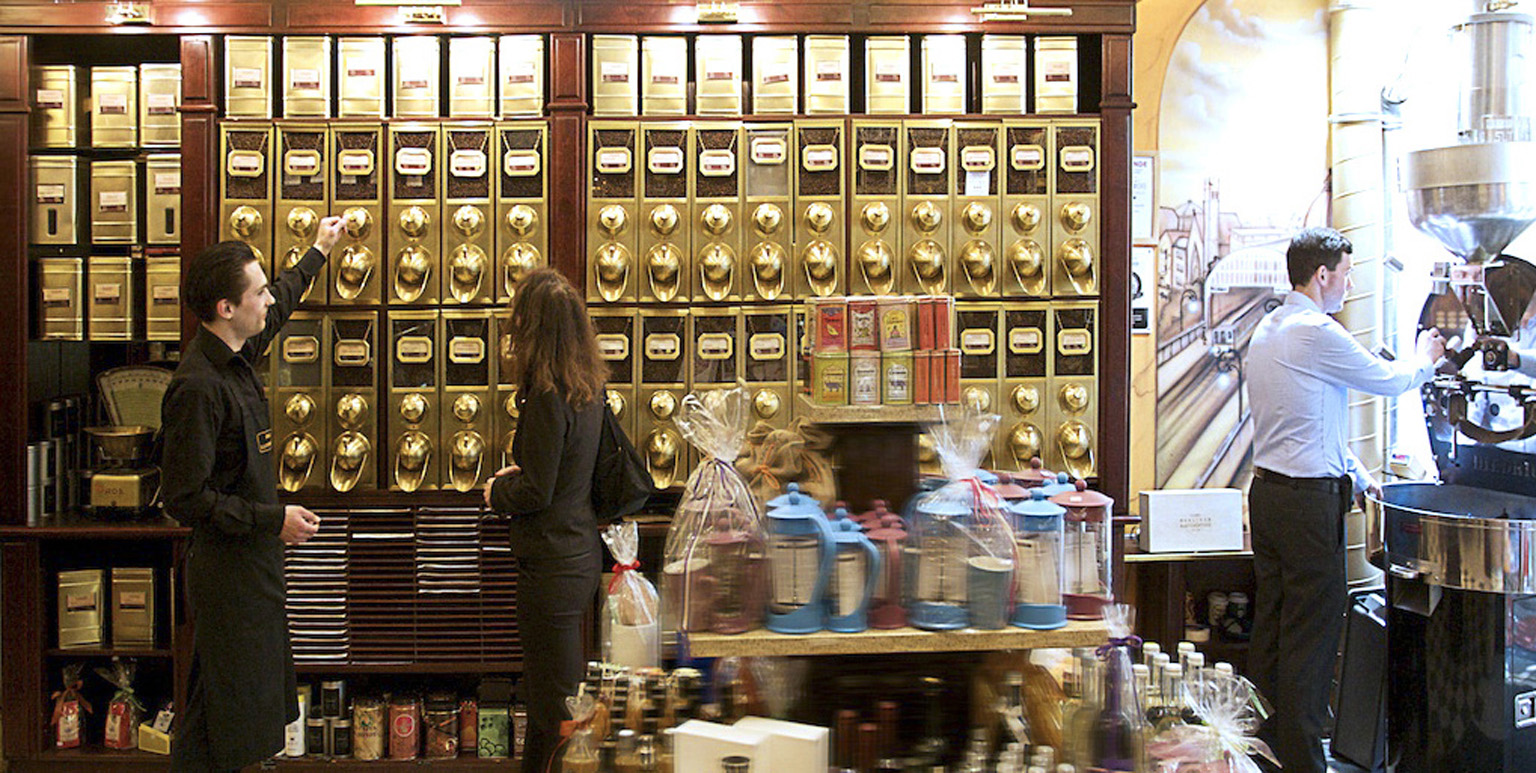
A variety of coffee beans on display at Berliner Kaffeerösterei
2. Café Wintergarten im Literaturhaus
![]() Fasanenstr. 23 • (030) 882 54 14 • Open 9am–midnight daily
Fasanenstr. 23 • (030) 882 54 14 • Open 9am–midnight daily
One of Berlin’s most beautiful cafés, this is based in the conservatory of an old city mansion. In summer guests can sit outside in the garden.
3. Café Savigny
![]() Grolmanstr. 53–54 • (030) 32 89 06 61 • Open 9am–1am daily
Grolmanstr. 53–54 • (030) 32 89 06 61 • Open 9am–1am daily
This gay and lesbian café, with traditional 19th-century interior, has tarts that are particularly worth trying.
4. Café Filmbühne am Steinplatz
![]() Hardenbergstr. 12 • (030) 312 65 89 • Open 9am–midnight Mon–Fri, 9am–1am Sat & Sun
Hardenbergstr. 12 • (030) 312 65 89 • Open 9am–midnight Mon–Fri, 9am–1am Sat & Sun
This coffee shop is popular thanks to the many students who frequent it.
5. Einstein Coffeeshop
![]() Kurfürstendamm 50a (off Ku’damm) • (030) 93 93 13 65 • Open 7:30am–8pm daily (from 8am Sat, 9am Sun)
Kurfürstendamm 50a (off Ku’damm) • (030) 93 93 13 65 • Open 7:30am–8pm daily (from 8am Sat, 9am Sun)
Probably the most popular outlet of this upmarket chain, this revamped café attracts the rich and beautiful of Charlottenburg. The terrace is the perfect spot to unwind with a coffee.
6. Café Hardenberg
![]() Hardenbergstr. 10 • (030) 312 26 44 • Open 9am–1am daily • No credit cards
Hardenbergstr. 10 • (030) 312 26 44 • Open 9am–1am daily • No credit cards
A favourite of students and artists since the 1850s, this café has a great atmosphere and reasonable prices.
7. Balzac Coffee
![]() Knesebeckstraße 1–2 • Open 7am–8pm Mon–Fri, 8am–8pm Sat, 8am–7pm Sun • No credit cards
Knesebeckstraße 1–2 • Open 7am–8pm Mon–Fri, 8am–8pm Sat, 8am–7pm Sun • No credit cards
A German gourmet coffee chain offering speciality drinks and snacks.
8. Der Kuchenladen
![]() Kantstr. 138 • (030) 31 01 84 24 • Open 10am–6:30pm daily • No credit cards
Kantstr. 138 • (030) 31 01 84 24 • Open 10am–6:30pm daily • No credit cards
Enjoy lemon tart and other deliciou s home-made delights at this tiny café.
9. Café Kleine Orangerie
![]() Spandauer Damm 20 • (030) 322 20 21 • Open 10am–6pm Tue–Sun
Spandauer Damm 20 • (030) 322 20 21 • Open 10am–6pm Tue–Sun
A small, pleasant garden café at the Charlottenburg Palace.
10. Schwarzes Café
![]() Kantstr. 148 • (030) 313 80 38 • Open around the clock
Kantstr. 148 • (030) 313 80 38 • Open around the clock
This alternative rock café offers excellent all-day breakfasts and is often packed until dawn.
Restaurants
1. Francucci’s
![]() Kurfürstendamm 90 • (030) 323 33 18 • Open noon–midnight daily • €€
Kurfürstendamm 90 • (030) 323 33 18 • Open noon–midnight daily • €€
This popular Tuscan restaurant serves up excellent pizza, homemade pasta and creative meat and fish dishes.
2. Alt-Luxemburg
![]() Windscheidstr. 31 • (030) 323 87 30 • Open 5pm–midnight Mon–Sat • €€
Windscheidstr. 31 • (030) 323 87 30 • Open 5pm–midnight Mon–Sat • €€
Since 1982, chef Karl Wannemacher has been dishing up exquisite French and German classics here.
3. Eiffel
![]() Kurfürstendamm 105 • (030) 891 13 05 • Open 9–1am daily • €€
Kurfürstendamm 105 • (030) 891 13 05 • Open 9–1am daily • €€
A spacious and charming French restaurant with outside tables and some dishes traditional to Berlin and the Mediterranean.
4. Die Quadriga
![]() Eislebener Str. 14 • (030) 21 40 50 • Open 6–11pm Tue–Sat • €€€
Eislebener Str. 14 • (030) 21 40 50 • Open 6–11pm Tue–Sat • €€€
With talented chef André Haufler at the reins, this intimate restaurant, in the Dormero Hotel (see Soho House) pairs creative French cuisine with an excellent wine selection. The elegant Art Deco salons overlook a Japanese garden.
5. Kuchi
![]() Kantstr. 30 • (030) 31 50 78 16 • Open noon–11pm daily • No credit cards • €€
Kantstr. 30 • (030) 31 50 78 16 • Open noon–11pm daily • No credit cards • €€
Thanks mainly to its exquisite sushi and mixed Asian hot dishes, this minimalist restaurant has a loyal clientele and ranks among the best sushi bars in town.
6. Lubitsch
![]() Bleibtreustr. 47 • (030) 882 37 56 • Open 10am–midnight Mon–Sat, 6pm–midnight Sun • €€
Bleibtreustr. 47 • (030) 882 37 56 • Open 10am–midnight Mon–Sat, 6pm–midnight Sun • €€
A small, elegant restaurant, serving fresh, regional cuisine.
7. Florian
![]() Grolmanstr. 52 • (030) 313 91 84 • Open 6pm–3am daily • €€
Grolmanstr. 52 • (030) 313 91 84 • Open 6pm–3am daily • €€
Fine Franconian food – inventive, robust and steadily high-quality – is on offer at this famed restaurant.

Outside tables at Florian
8. Mine Restaurant
![]() Meinekestrasse 10 • (030) 88 92 63 63 • Open 6pm–midnight Tue–Sat • €€
Meinekestrasse 10 • (030) 88 92 63 63 • Open 6pm–midnight Tue–Sat • €€
Serving exciting Italian cuisine, this restaurant houses a wine bar with an array of wines.
9. Marjellchen
![]() Mommsenstr. 9 • (030) 883 26 76 • Open 5pm–midnight daily • €€
Mommsenstr. 9 • (030) 883 26 76 • Open 5pm–midnight daily • €€
This delightful restaurant serves hearty dishes from East Prussia, Pomerania and Silesia.
10. Ana e Bruno
![]() Sophie-Charlotten-Str. 101 • (030) 325 71 10 • Open 5pm–midnight daily • €€€
Sophie-Charlotten-Str. 101 • (030) 325 71 10 • Open 5pm–midnight daily • €€€
Friendly and extremely elegant, Ana e Bruno is an excellent Italian restaurant in Berlin.
